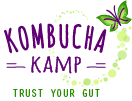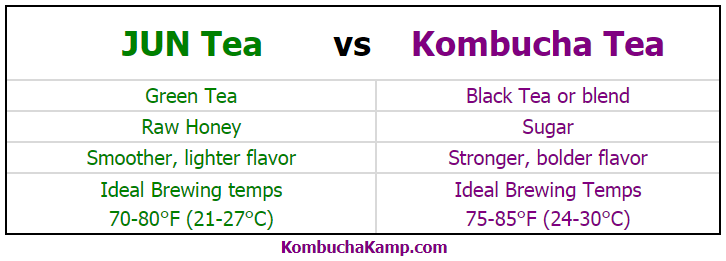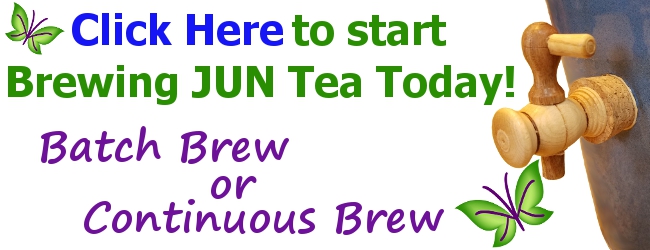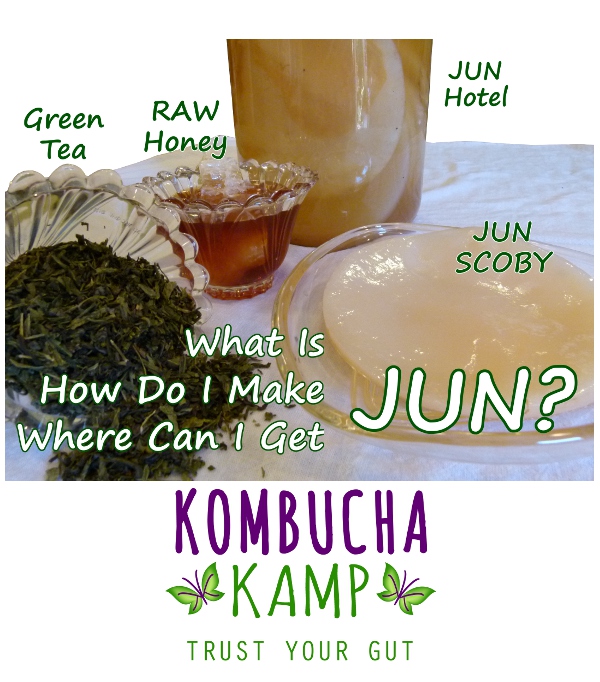
What is JUN Tea?
JUN Tea is another delicious ferment you can make at home. Similar though not exactly the same, JUN Tea is like Kombucha’s raw honey and green tea-loving cousin.
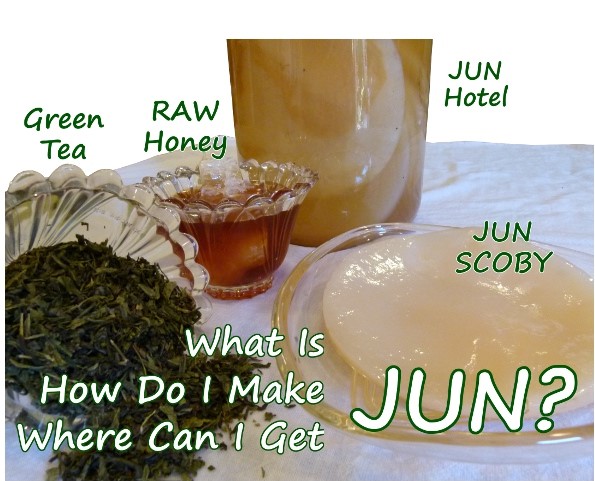
Though the brew produces a culture that looks like a Kombucha SCOBY, a genuine JUN Culture naturally harmonizes with the organisms present in raw honey. This makes a typical JUN brew lighter and smoother, refreshing, floral, and often quite fizzy. In fact, due to the concentrated sugars and nutrients in the honey, JUN can often be even bubblier than it’s cousin, earning it the nickname “Champagne of Kombucha.”
Let’s dive in to see what makes Jun different from Kombucha.
How is JUN Tea different than Kombucha Tea?
JUN is a unique culture, separate from Kombucha, but potentially related. When it comes to caring for JUN Cultures, or even the basic recipe instructions, Kombucha and JUN have a lot in common. That means most of the information you can find on this site about Kombucha will apply to JUN Tea as well. For example, the primary bacteria family for both Kombucha and JUN is Acetobacter, which is responsible for building the SCOBY made of bacterial cellulose. Some claim there is no yeast in JUN but that is not accurate (yeast are everywhere!).
However, there are a few notable differences. Let’s look at them.
Ingredients
Raw Honey (JUN) vs Sugar or Pasteurized Honey (Kombucha)
As mentioned above, JUN is brewed with RAW honey only, meaning unpasteurized. Using regular sugar produces a bad smelling brew due to sick yeast, and often mold. Kombucha can be made with a wide variety of sugars, including pasteurized honey. Making Kombucha with raw honey generally leads to very poor flavors, a lack of SCOBY growth, and again, mold.
Green Tea Only
Traditionally, Kombucha was brewed with black tea only. However, a blend of black and green tea is more common today. By contrast, JUN is “traditionally” made with green tea. The reduced amount of tannins in green tea contributes to JUN’s lighter color and lighter flavor profile. For that same reason, a Jun culture often is whiter in appearance.
Behavior
Brewing Cycle
JUN Tea brews a bit faster than Kombucha. The main reason is honey, which is easier for the bacteria and yeast to begin eating as soon as the brew starts. Regular sugar requires extra processing before they can eat, so the brew takes a few days longer. Another factor that speeds the JUN brew is the other nutrients in the honey, which provide even more fuel for the ferment. As always, taste is king and your taste buds will tell you when the JUN has the right sweet/sour balance that works best for your flavor profile. Many find that they are ready to harvest the JUN after 4-7 days rather than 7-10 for a gallon of Kombucha.
Temperature
To balance the faster brewing cycle, and help maintain a smoother flavor overall, JUN does best at a slightly lower temperature range about 5°F below Kombucha. That makes the ideal range for JUN 70-80°F (21-27°C) with 75°F (24°C) being the sweet spot. Beware: those who like a lighter brew flavor should stay closer to the low end of the temperature range, but brewing at 65°F (18°C) or below can cause mold issues. Despite these minor yet important differences, nearly every other aspect of the brewing process is identical and Jun is also great for Continuous Brew as well as Batch Brew.
Reproduction
While some people claim a JUN Tea brew will not grow a new JUN Tea culture, we know that all fermentation cultures perpetuate via reproduction, and JUN is no different. The culture may not reproduce as quickly as a Kombucha SCOBY, potentially due to the shorter fermentation cycle or perhaps because every type of raw honey differs in it’s exact composition. If only thin layers of new JUN culture form, keep them together to start a JUN SCOBY Hotel. Often a thick JUN will form on a Hotel if you do not disturb it for many weeks.
********
JUN Tea Recipe
Keeping the above adjustments in mind, we recommend using the standard Kombucha Recipe here and simply substituting green tea and raw honey (1 cup per gallon). Taste earlier in the process than you would Kombucha. Flavoring and bottling will be the same, but watch out for that extra carbonation! More about safe bottling and flavoring for Kombucha or JUN here.
JUN Tea as Continuous Brew
JUN Tea is another delicious option as a Continuous Brew. Because JUN can mature faster than Kombucha, it is even easier to have plenty of fresh brew on hand. Although JUN is a cousin of Kombucha, all the basic concepts of Continuous Brew will apply, meaning that set up, SCOBY care, maintenance and more are essentially identical.
Any Continuous Brew Kit offered by Kombucha Kamp can be ordered as a JUN Kit instead, simply by using the drop down menu in each product. You will receive genuine JUN cultures and RAW honey (Complete and Deluxe packages only), plus we will substitute all Green Tea with your package, ideal for making delicious JUN Tea. Visit any package to select your JUN Continuous Brew!
Where did JUN come from?
Kombucha has a number of ancient origin stories, mostly without written proof. Somehow, the legends around JUN are even more fantastical. Some people claim that a true JUN culture will never reproduce. Others say Jun was cultivated by Buddhist monks in Tibet or that only the holiest of Daoists were permitted to have a culture. But a precious number of JUN were smuggled out and delivered to a chosen few people in the west. Only they can make true JUN! (With stolen property apparently? How enlightened!)
As thrilling as these stories can be, there is no written evidence to support them. These kind of legends are sometimes also attributed to other cultures such as milk kefir grains.
But most importantly, these legends don’t make sense when we think about the history of fermenting. Cultures like Kombucha SCOBYs, water kefir grains, yogurt, cheese and others require specific conditions and care, but by nature they are hardy and reproductive. It’s how they survive with us lazy and dirty humans for so long!
So where did JUN really come from? Nobody knows for sure, but a JUN culture could have occurred randomly on a cup of sweet tea or in a vat of honey wine, such as in the Kombucha origin story here. The important thing is that it ferments well with raw honey and tea to make a flavor you enjoy!
What are the Health Benefits of JUN Tea?
First of course, we are not doctors and this is not for diagnosing or treating anything. JUN is a food, nothing more. None of these statements have been evaluated by the FDA. Since JUN seems to be a relative newcomer to the fermentation scene, it has not been the subject of research. We can only speculate on potential benefits.
We know that the same organisms that make vinegar and Kombucha are present due to the culture formation, so the digestive benefits of those other beverages are likely the same for JUN Tea. Like Kombucha, its tea based, which has its own host of benefits: anti-cancer, weight loss and so on. The honey itself has been studied to have potentially antioxidant, antibacterial and memory improving characteristics. Fermentation can increase vitamin, nutrient, and healthy organic acid content while reducing glycemic effects.
These are all theoretical benefits. Our philosophy is Trust YOUR gut – so if you enjoy drinking JUN and your feedback loop is giving you the green light, then go for it!
NOT FINDING RAW HONEY LOCALLY?
KKAMP HAS YOU COVERED WITH USA GROWN RAW HONEY!
********
JUN Tea Flavoring Suggestions
Pretty much any Kombucha flavoring suggestion will work with JUN. But, JUN Tea also lends itself to floral and fruity combinations especially. Give these flavorings a try and then experiment with whatever is blooming in your garden, in season at the farmer’s market, or grab some of our dried spices to spruce up your local fruits. All measurements are per 16oz bottle. Scale up or down depending on your personal taste preference.
Rose Elderflower
This combination has a slight tang from the vitamin C naturally present in rose petals combined with the champagne-y flavor of elderflower blossoms.
- ¼ tsp elderflower
- 1 tsp rose petals
Strawberry Basil
Summer strawberries are sweet and a little tart. Basil (THRIVE , AMZ) is a perfect foil for the fruitiness
- 1 TB fresh strawberries, diced
- ½ tsp dried or 1 tsp fresh basil leaves
Peppermint Watermelon
Cool and refreshing year round!
- 1 TB fresh watermelon, pureed or mashed
- ½ tsp dried or 1 tsp fresh peppermint leaves
